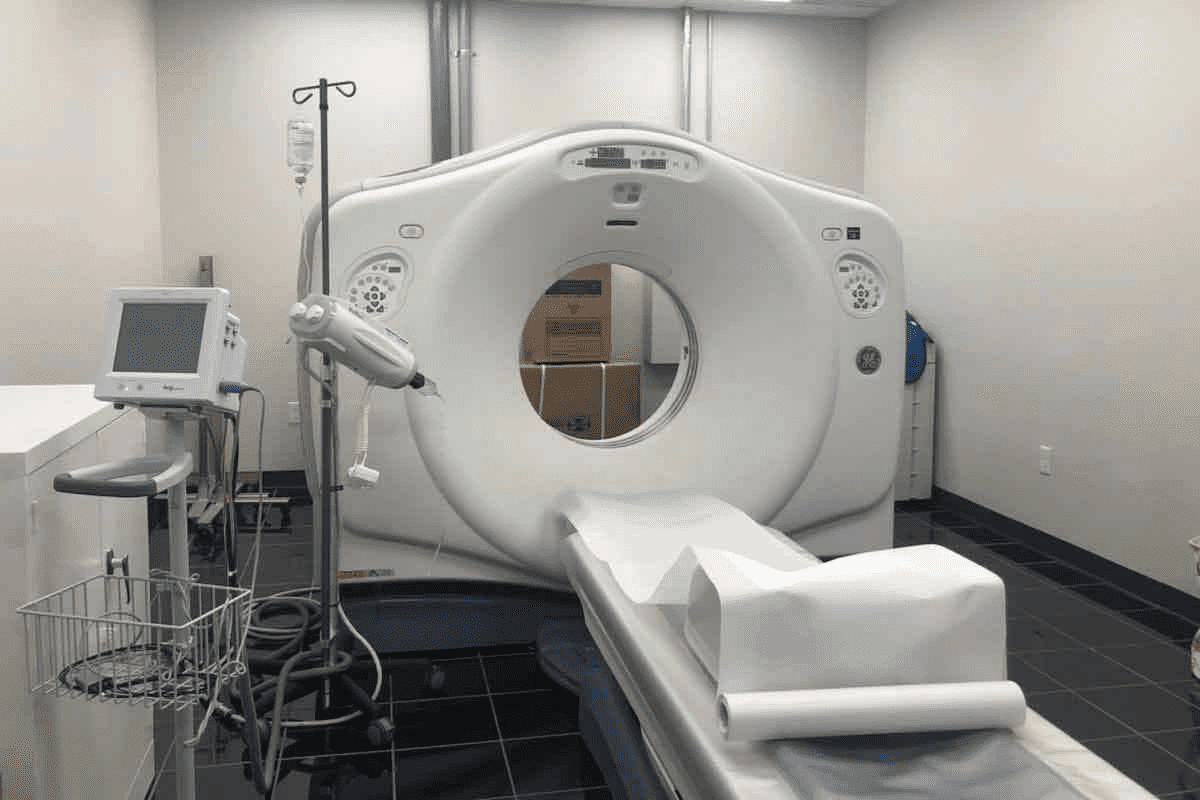Last Updated on November 26, 2025 by Bilal Hasdemir

Nearly 80% of ovarian cancer cases are diagnosed late. This is because the symptoms are often vague and similar to other conditions. This delayed diagnosis significantly impacts treatment outcomes and survival rates.
It’s important to know where ovarian cancer first spreads. This knowledge helps doctors choose the best treatments. The disease’s initial spread can greatly affect the prognosis.
Key Takeaways
- Ovarian cancer is often diagnosed at a late stage due to non-specific symptoms.
- The initial spread of the disease affects treatment options and outcomes.
- Understanding the spread is key for effective treatment planning.
- Early detection can significantly improve survival rates.
- Advanced stages require more aggressive treatment approaches.
Understanding Ovarian Cancer
It’s key to know about ovarian cancer for early detection and treatment. Ovarian cancer is a disease where cells in the ovaries grow out of control.
Ovarian cancer isn’t just one disease. It’s a group of cancers, each with its own traits. The most common one starts in the outer layer of the ovary.
Types and Subtypes of Ovarian Cancer
Ovarian cancer is divided into types based on where it starts. The main types are:
- Epithelial ovarian cancer
- Germ cell tumors
- Sex cord-stromal tumors
Epithelial ovarian cancer has subtypes like serous, mucinous, clear cell, and endometrioid carcinomas. Each subtype has its own features.
| Type | Subtype | Characteristics |
| Epithelial | Serous | Most common subtype, often diagnosed at advanced stage |
| Epithelial | Mucinous | Less common, often larger tumors |
| Germ Cell | Dysgerminoma | Most common germ cell tumor, often affects younger women |
Risk Factors and Prevalence in the United States

Several factors can raise a woman’s risk of ovarian cancer. These include:
- Family history of ovarian or breast cancer
- Genetic mutations (e.g., BRCA1 and BRCA2)
- Age (risk increases after 50)
- Reproductive history (e.g., never having children or having children late in life)
In the United States, ovarian cancer is the fifth leading cause of cancer deaths among women. The American Cancer Society reports about 19,680 new cases in 2022, leading to around 12,740 deaths.
Knowing these risk factors and the prevalence of ovarian cancer is vital. It helps in creating effective prevention and early detection plans.
The Process of Cancer Metastasis
Metastasis is when cancer cells spread to new parts of the body. It’s a complex process. It starts with cancer cells leaving the main tumor and ends with them forming new tumors in other organs.
How Cancer Cells Break Away from Primary Tumors
The first step in cancer spreading is when cancer cells leave the main tumor. This happens because the cells change how they stick together. The loss of adhesion molecules lets them move away from other cells. This change helps them invade nearby tissues.
Once they’re free, cancer cells can move into nearby tissues. They can also get into the bloodstream or lymphatic system. This is a key step because it lets them travel to other parts of the body.
Mechanisms of Cancer Cell Travel and Attachment
After getting into the bloodstream or lymphatic system, cancer cells can go anywhere in the body. The circulation of cancer cells helps them reach distant organs. There, they might start new tumors.
When cancer cells reach new places, they stick to the blood vessel walls. Adhesion molecules help them stop in the blood vessels of target organs. This is how they settle in and start growing new tumors.
| Step | Description | Key Factors Involved |
| 1. Detachment | Cancer cells break away from the primary tumor | Loss of adhesion molecules |
| 2. Invasion | Cancer cells invade surrounding tissues | Migratory phenotype, invasion factors |
| 3. Circulation | Cancer cells enter the bloodstream or lymphatic system | Bloodstream, lymphatic vessels |
| 4. Arrest | Cancer cells attach to new sites | Adhesion molecules, endothelial cells |
Ovarian Cancer First Spread Patterns
It’s key to know how ovarian cancer spreads first to treat it well. This cancer can move in many ways, affecting different body parts.
Direct Extension vs. Distant Metastasis
Ovarian cancer can spread in two main ways: direct extension and distant metastasis. Direct extension happens when cancer cells move to nearby organs and tissues. Distant metastasis is when cancer cells go to far-off places through the blood or lymph system.
At first, cancer often spreads directly to nearby organs and the pelvic area. Later, it can go to places like the liver, lungs, or brain through distant metastasis.
Typical Progression Timeline
The time it takes for ovarian cancer to grow varies. Knowing how it usually progresses helps in planning treatment and care.
It starts at Stage I, where cancer is only in the ovaries, and goes up to Stage IV, where it’s in distant organs. How fast it grows depends on the cancer type, the patient’s health, and the first treatment’s success.
Stage I to Stage IV Progression

The journey from Stage I to Stage IV ovarian cancer includes several steps:
- Stage I: Cancer is only in the ovaries.
- Stage II: Cancer has spread to other pelvic organs.
- Stage III: Cancer has spread to the peritoneum outside the pelvis or to nearby lymph nodes.
- Stage IV: Cancer has spread to distant organs like the liver, lungs, or outside the belly.
Knowing these stages and how ovarian cancer spreads is vital for finding the best treatment and better patient outcomes.
Peritoneal Spread: The Primary Route
Peritoneal spread in ovarian cancer occurs when cancer cells travel through the peritoneal fluid, carrying the disease across the abdomen.It’s key to understanding how ovarian cancer grows and how to treat it.
Entry into the Peritoneal Cavity
Cancer cells from ovarian tumors can invade the peritoneal cavity. The peritoneal cavity is lined with mesothelial cells. This makes it a space for cancer cells to spread. Cancer cells get into the cavity by breaking through the ovarian surface.
Peritoneal Fluid Circulation and Cancer Seeding
The peritoneal fluid is important for spreading ovarian cancer cells. This fluid moves around the abdomen, carrying cancer cells to different places. As cells move, they can stick to and grow on the peritoneal surfaces, a process called seeding.
| Location | Frequency of Metastasis | Clinical Significance |
| Omentum | High | Often involved early in peritoneal spread |
| Small Bowel Surface | Moderate | Can lead to bowel obstruction |
| Large Bowel Surface | Moderate | May cause bowel dysfunction |
Malignant Ascites Formation
In advanced stages, cancer can cause malignant ascites. This is when fluid builds up in the abdomen with cancer cells. It makes managing ovarian cancer harder, often needing treatments like paracentesis to help symptoms.
Understanding how cancer spreads is key to treating ovarian cancer. Knowing the patterns helps doctors manage the disease better and improve patient care.
Spread to Adjacent Reproductive Organs
Ovarian cancer often spreads to nearby reproductive organs as it grows. This movement is key to understanding the disease’s progress. It also affects treatment choices and results.
Fallopian Tubes Involvement
The fallopian tubes are close to the ovaries, making them a common site for cancer spread. Research shows that cancer can start in the fallopian tubes early on. This is more likely when cancer begins at the fimbrial ends of the tubes.
Key factors contributing to fallopian tube involvement include:
- Anatomical proximity to the ovaries
- Shared epithelial characteristics
- Potential for cancer cells to seed along the tubal surface
Uterine and Cervical Spread Patterns
Ovarian cancer can reach the uterus and cervix. It can spread directly or through the lymphatic system. The way it spreads to these areas affects how the disease is treated and managed.
| Site of Spread | Common Patterns of Involvement |
| Uterus | Direct extension, lymphatic spread |
| Cervix | Lymphatic spread, less commonly direct extension |
The spread of ovarian cancer to the uterus and cervix shows how complex the disease is. It emphasizes the importance of thorough staging and treatment planning.
Abdominal Cavity Seeding
Abdominal cavity seeding is a key part of ovarian cancer growth. It happens when cancer cells break off from the main tumor in the ovaries. Then, they attach to the surfaces inside the abdominal area.
Omentum as a Common First Site
The omentum, a fatty tissue, covers the organs in the belly. It’s often where ovarian cancer first spreads. This is because it has a lot of blood and special immune spots called milky spots.
Omentum Involvement: Research shows the omentum is often the first place ovarian cancer spreads in the belly.
Small Bowel Surface Involvement
Cancer cells can also attach to the small bowel’s surface. This can cause blockages or other problems.
Clinical Implications: When the small bowel is involved, surgery can be more complicated. Special techniques might be needed.
Large Bowel Surface Metastasis
The large bowel can also get cancer cells. This can cause serious issues like blockages and the need for surgery.
| Site of Metastasis | Frequency | Clinical Implications |
| Omentum | High | Often first site, rich blood supply |
| Small Bowel Surface | Moderate | Bowel obstruction risk |
| Large Bowel Surface | Moderate | Surgical complications, obstruction |
It’s important to know how ovarian cancer spreads in the belly. This helps doctors find better ways to treat it. The involvement of the omentum, small bowel, and large bowel shows how complex ovarian cancer can be. It highlights the need for detailed treatment plans.
Pelvic Organ Involvement
Ovarian cancer often spreads to the pelvic organs as it grows. This can change the disease’s stage, treatment choices, and outlook.
The bladder, rectum, and sigmoid colon are usually affected. Knowing how cancer spreads to these areas is key to managing the disease well.
Bladder Surface Metastasis
Ovarian cancer can reach the bladder’s surface. This happens through direct growth or by seeding in the pelvic area. Bladder involvement may cause frequent urination, urgency, or blood in the urine.
- Direct extension from the primary ovarian tumor
- Seeding of cancer cells within the pelvic cavity
- Involvement of the bladder wall, potentially causing obstructive symptoms
Rectal and Sigmoid Colon Spread
The rectum and sigmoid colon are also common sites for ovarian cancer spread. This happens through direct extension and peritoneal seeding, similar to bladder involvement.
Symptoms of rectal and sigmoid colon involvement include changes in bowel habits, constipation, or rectal bleeding. The extent of involvement can range from superficial mucosal lesions to deeper invasion of the bowel wall.
- Peritoneal seeding leading to metastatic deposits on the rectal and sigmoid colon surfaces
- Direct invasion from adjacent ovarian cancer masses
- Potential for bowel obstruction in advanced cases
Understanding how far cancer has spread in the pelvis is vital for staging and treatment planning. Accurate assessment of spread to organs like the bladder, rectum, and sigmoid colon is essential for choosing the best treatments.
Upper Abdominal Spread
It’s important to know how ovarian cancer spreads to the upper abdomen. This knowledge helps in treating the disease effectively. Ovarian cancer can spread to different organs in the upper abdomen, affecting patient outcomes.
Liver Surface Metastasis
The liver is a common site for ovarian cancer to spread in the upper abdomen. Cancer cells can grow on the liver’s surface, forming tumors. This spread is often seen in advanced cases and can make surgery harder.
Liver metastasis can cause a lot of problems. Doctors consider it when planning treatment for ovarian cancer.
Diaphragm and Spleen Involvement
The diaphragm, a muscle between the chest and abdomen, can also be affected. Cancer can spread to it through direct contact or through fluid in the abdomen. The spleen, which helps fight infections, can also be involved, though it’s less common.
Diaphragmatic involvement can cause issues like fluid in the lungs, making treatment harder. Spleen involvement is rare but poses big challenges for surgery.
In summary, ovarian cancer spreading to the upper abdomen, including the liver, diaphragm, and spleen, is complex. Knowing how it spreads helps doctors develop better treatment plans.
Lymphatic System Spread
It’s key to know how ovarian cancer moves through the lymphatic system for good treatment. This system, with its vessels and nodes, helps fight off infections. It can also let cancer spread.
Pelvic Lymph Node Involvement
Ovarian cancer often goes to the pelvic lymph nodes first. These nodes are in the pelvis and help drain lymph from the pelvic area. When cancer cells get into these nodes, it can spread further.
Studies show that many ovarian cancer patients have nodes in the pelvis involved. This affects their treatment and how well they might do.
The nodes in the pelvis are close to the ovaries. This makes it easy for cancer cells to get there from the main tumor. They can travel through the lymphatic vessels.
Key factors influencing pelvic lymph node involvement include:
- The stage and grade of the ovarian cancer
- The presence of lymphovascular space invasion
- The extent of tumor spread within the pelvic cavity
Para-aortic and Distant Lymph Node Spread
As ovarian cancer gets worse, it can move to the para-aortic lymph nodes and other distant nodes. The para-aortic nodes are near the aorta and are a common place for cancer to go. This happens when cancer cells travel through the lymphatic vessels from the pelvic nodes to the para-aortic nodes.
Distant lymph node spread can happen in nodes in the neck, chest, or other places. This is often seen in advanced ovarian cancer. It makes treatment harder.
- Initial spread to pelvic lymph nodes
- Subsequent involvement of para-aortic lymph nodes
- Potential spread to distant lymph nodes
Knowing these patterns is key for good treatment plans. The way ovarian cancer spreads through the lymphatic system shows why we need detailed staging and targeted treatments.
Distant Metastasis Patterns
It’s key to know how ovarian cancer spreads to other parts of the body. This is called distant metastasis. It happens when cancer cells from the ovary move to other areas, usually through blood or lymphatic systems.
Pleural Cavity and Lung Involvement
The area around the lungs, called the pleural cavity, is a common place for cancer to spread. Cancer cells can get there by moving from the ovary or through lymphatic spread. Pleural effusion, or fluid buildup, often causes breathing problems and chest pain.
Lungs can also get involved through direct invasion or blood. This can lead to breathing issues and may need treatments like thoracentesis to ease symptoms.
Brain, Bone, and Other Distant Sites
While rare, ovarian cancer can spread to the brain in later stages. Brain metastasis can cause headaches, seizures, and changes in thinking. Treatment usually includes surgery, radiation, and chemotherapy.
Bone metastasis, though rare, can cause a lot of pain and increase fracture risk. Common spots include the spine, pelvis, and long bones. Treatment options include radiation, bisphosphonates, and pain management.
Other distant sites like the liver and skin can also be affected in advanced ovarian cancer. The spread pattern shows how aggressive the tumor is and the patient’s health.
- Key Sites for Distant Metastasis:
- Pleural cavity and lung
- Brain
- Bone
- Liver
- Skin
Knowing these patterns helps doctors plan better treatments. It also helps patients understand possible complications.
Diagnosing Ovarian Cancer Spread
Diagnosing how far ovarian cancer has spread involves several steps. These include using imaging and surgical methods. It’s key to know how far the cancer has spread to plan the right treatment.
Imaging Techniques
Imaging is a big part of finding out how far ovarian cancer has spread. Here are some ways:
- CT Scans: Give detailed pictures of the belly and pelvis. They help spot where the tumor has spread.
- MRI: Shows soft tissues in high detail. It’s good for seeing how far the cancer has gone.
- PET Scans: Find cancer cells that are active. They help spot cancer in other parts of the body.
Surgical Staging Procedures
Surgery is also key in figuring out how far ovarian cancer has spread. It includes:
- Exploratory Laparotomy: A surgery that lets doctors see inside the belly.
- Biopsy: Taking tissue samples to check for cancer.
- Lymph Node Dissection: Taking out lymph nodes to see if cancer has spread there.
Biomarkers and Liquid Biopsies
Biomarkers and liquid biopsies are new tools for finding out how far ovarian cancer has spread.
- CA-125: A marker that often goes up in ovarian cancer. It helps track how the disease is doing.
- Liquid Biopsies: Check for cancer DNA in blood or other fluids.
Using all these methods together makes diagnosing ovarian cancer spread more accurate. This helps doctors create better treatment plans.
Treatment Implications of Different Spread Patterns
Knowing how ovarian cancer spreads is key to finding the best treatment. The spread pattern affects the treatment choice. This might include surgery, chemotherapy, targeted therapy, or a mix of these.
Surgical Approaches Based on Spread Location
The surgery for ovarian cancer depends on where and how much the cancer has spread. If the cancer is mainly in the ovaries or nearby, a less invasive surgery might work. But, if it has spread a lot in the belly or to other places, more surgery is needed.
Surgical options may include:
- Removing the ovaries and fallopian tubes
- Removing the uterus
- Omentectomy (taking out the omentum)
- Debulking surgery to remove as much tumor as possible
Chemotherapy and Targeted Therapy Considerations
Chemotherapy is a big part of treating ovarian cancer, mainly when it’s spread beyond the ovaries. The chemotherapy choice depends on how far and where the cancer has spread, and the patient’s health.
Targeted therapy, which targets specific cancer molecules, is also used. For example, PARP inhibitors are promising for certain genetic ovarian cancers.
Emerging Treatments for Specific Metastatic Sites
There’s ongoing research into treatments for specific cancer sites. For instance, intraperitoneal chemotherapy puts drugs directly in the belly. This can help when cancer has spread there.
New treatments like immunotherapy and more precise targeted therapies are being explored. Clinical trials are key to checking if these treatments work and are safe.
Survival Rates by Stage
Survival rates for ovarian cancer depend on the disease’s stage at diagnosis. Knowing these rates helps patients and doctors make better treatment choices.
Factors Influencing Survival Rates
Many things affect how long ovarian cancer patients live. These include the disease’s stage, the patient’s age, overall health, and how well they respond to treatment.
Stage at Diagnosis: The stage at diagnosis greatly affects survival chances. Being diagnosed early is usually better.
According to the American Cancer Society, ovarian cancer survival rates are about 90% if caught at stage I. But, if diagnosed at stage III or IV, survival rates drop to around 30%.
“The stage of ovarian cancer at diagnosis is a critical determinant of survival. Early detection through screening and awareness can significantly improve outcomes.”
Factors Affecting Prognosis and Recurrence
Many factors influence how well a patient will do and if the cancer will come back. These include:
- The specific type and subtype of ovarian cancer
- The grade of the tumor
- The presence of genetic mutations like BRCA1 and BRCA2
- The patient’s overall health and age
| Stage at Diagnosis | 5-Year Survival Rate |
| Stage I | 90% |
| Stage II | 70% |
| Stage III | 39% |
| Stage IV | 17% |
The table shows survival rates drop as the disease stage increases. This highlights the need for early detection and effective treatments.
Conclusion
It’s important to know how ovarian cancer spreads to manage it well. Ovarian cancer can move in different ways, like spreading directly, through lymph nodes, or to distant places. The peritoneal cavity, with the omentum, is often where it goes first.
Knowing how ovarian cancer spreads helps doctors figure out the stage and plan treatment. Surgery and imaging help see how far the cancer has gone. This knowledge helps doctors make better treatment plans for patients.
Treating ovarian cancer needs a full plan because it’s a complex disease. By understanding how it spreads, doctors and patients can work together. This teamwork helps improve survival chances and quality of life.
FAQ
Where does ovarian cancer typically spread first?
Ovarian cancer often starts by spreading to the peritoneal cavity. This area includes the surfaces of the abdominal organs and the omentum, a fatty tissue layer.
What are the common first sites of ovarian cancer metastasis?
The first places cancer spreads to include the omentum, pelvic organs like the fallopian tubes and uterus, and the surfaces of the small and large bowel.
How does ovarian cancer spread to the peritoneal cavity?
Cancer cells can move into the peritoneal cavity through direct extension from the primary tumor. They then spread through peritoneal fluid, seeding on various surfaces.
Can ovarian cancer spread to the lymph nodes?
Yes, ovarian cancer can spread through the lymphatic system. This involves pelvic lymph nodes, para-aortic lymph nodes, and more distant lymph nodes.
What is the role of the omentum in ovarian cancer spread?
The omentum is a common first site for metastasis. This is because of its location in the peritoneal cavity and its tendency to accumulate cancer cells.
How does ovarian cancer involve the bowel surfaces?
Cancer cells can seed on the surfaces of the small and large bowel. This can lead to bowel obstruction or other complications.
Can ovarian cancer spread to the upper abdominal organs?
Yes, ovarian cancer can metastasize to the liver surface, diaphragm, and spleen, among other upper abdominal organs.
What are the patterns of distant metastasis in ovarian cancer?
Distant metastasis can occur to the pleural cavity and lung, brain, bone, and other distant sites. This is often through the lymphatic or hematogenous routes.
How is the spread of ovarian cancer diagnosed?
Diagnosis involves imaging techniques like CT, MRI, and PET scans. Surgical staging procedures and biomarkers are also used, along with liquid biopsies.
How does the pattern of spread affect the treatment of ovarian cancer?
Treatment is tailored based on the extent and location of spread. This includes surgical approaches, chemotherapy, targeted therapy, and emerging treatments for specific metastatic sites.
What are the survival rates for ovarian cancer based on the stage at diagnosis?
Survival rates vary significantly based on the stage at diagnosis. Earlier stages have better prognosis, while later stages have poorer outcomes.
What factors affect the prognosis and likelihood of recurrence in ovarian cancer?
Factors affecting prognosis include the stage at diagnosis, the extent of residual disease after surgery, and the response to chemotherapy, among others.
References
- McCluggage, W. G. (2018). Morphological subtypes of ovarian carcinoma: a review with emphasis on new developments and pathogenesis. Pathology, 50(5), 479“490. https://doi.org/10.1016/j.pathol.2018.02.004






